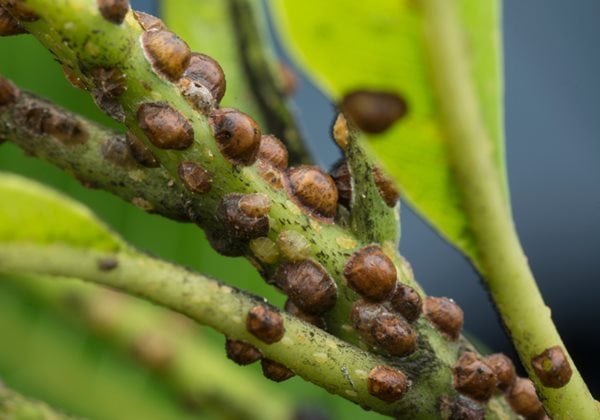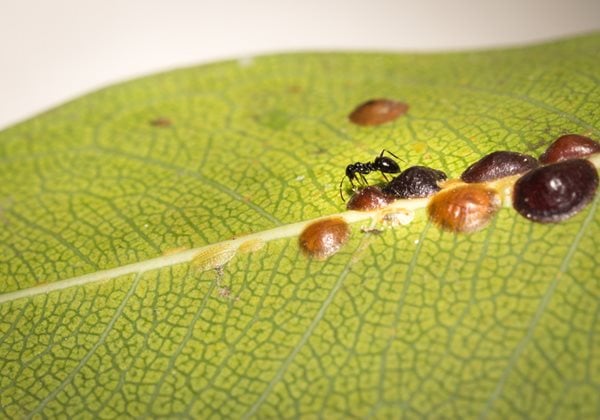How to Identify & Control Scale Insects
Get these pests under control before they cause serious harm to your plants
Photo by: Young Swee Ming / Shutterstock
Scale insects are one of the most common and damaging garden pests, occurring on outdoor plants as well as houseplants and can be difficult to identify and eradicate. There are more than 8,000 species of scale, which feed on leaves, stems, and branches, causing widespread damage in severe cases.
Scale feed by sucking plant sap through long, needle-like mouthparts. Some species also secrete a sticky substance called honeydew, which supports the growth of a fungal disease (sooty mold) and also attracts ants. Both the extraction of plant sap and honeydew deposits can cause damage to plants.
Since scale bugs are often mistaken for other pests or bacterial or fungal diseases, it’s crucial to properly diagnose the presence of scale before administering any treatments.
On this page: What Are Scale? | Types | Get Rid of Scale | Prevent Scale | Recognize the Presence of Scale | Identify Damage | Plants Susceptible | Houseplants
On this page:
- WHAT ARE SCALE?
- TYPES OF SCALE
- HOW TO GET RID OF SCALE ON PLANTS
- HOW TO PREVENT SCALE
- RECOGNIZE THE PRESENCE OF SCALE
- IDENTIFY SCALE DAMAGE ON PLANTS
- PLANTS SUSCEPTIBLE TO SCALE
- SCALE ON HOUSEPLANTS
WHAT ARE SCALE INSECTS?
Scale are related to aphids
Gnat-like males have wings, are seldom seen, and do not have the ability to feed. Females are immobile, lacking wings or visible legs. Eggs, which are laid underneath the female’s protective shell, take 1 to 3 weeks to hatch into nymphs (crawlers). Nymphs have legs and move only a short distance before settling down to feed. The protective shell develops soon after feeding begins. Females and nymphs remain in the same location for the duration of their life span.
TYPES OF SCALE INSECTS
There are two basic types of scale bugs, armored and soft-shelled. Mealybugsare also a type of scale.
Armored scale (Diasipidae) are smaller and have a hard, flattened protective shell that makes them more difficult to eradicate. They tend to feast on outdoor trees and shrubs rather than indoor houseplants. Armored scale don’t produce honeydew, so sooty mold is not a problem. They can produce 3 or 4 generations per year, with the ability of eggs, nymphs, or adult females to overwinter.
Soft scale (Coccidae) produce a soft waxy protective layer and are distinguished by their larger size and rounded or oval dome shape that resembles tiny turtle shells. They secrete honeydew and are the type most often found in greenhouse or indoor environments. Soft scale typically produce one or two generations per year.
HOW TO GET RID OF SCALE ON PLANTS
Scale can be difficult to treat because their protective coating renders most insecticides ineffective. Natural or mechanical controls are the most effective way to manage infestations. If scale insects are present, try these methods:
Monitor:
Since no insecticide is effective once the soft or hard shell has formed, monitor your plants for the presence of scale. Watch for the first crawler stage in spring, which is when the insects are most vulnerable; wash and then spray.Use water:
For minor infestations, use a gentle blast from a hose to dislodge eggs, nymphs, or adults. Dispose in a bucket of soapy water to kill them. Wipe down leaves or stems that exhibit sooty mold.
Prune branches:
Cut out the most heavily infested branches or stems and discard in the garbage or yard debris bin. Don’t compost affected plant material.
Use natural predators:
Insects that prey on scale offer natural pest control. These include parasitic wasps, soldier beetles, lacewings, and ladybugs. Provide habitat to attract and keep these insects around. Beneficial insects can be purchased at local garden centers or by mail order.
Apply horticultural oil:
Organic horticultural oil such as neem oil is effective on eggs, nymphs, and adults, as the oil will coat and suffocate the insects. Provide good coverage for the entire plant. To control overwintering eggs and insects, apply oil in spring before leaves emerge. Several applications may be necessary. Follow instructions carefully, as some plants may be sensitive, and oils are best applied in a particular temperature range. (Read more on how to use neem oil.)
Use insecticidal soap:
Use a commercial insecticidal soap or a homemade recipe. This remedy is most effective in the crawler stage before scale develop their protective coating. Several applications may be necessary.
Keep it organic:
Though chemical insecticides may control scale infestations, the resulting harm to beneficial insects, wildlife, and the environment is not worth the risk.
HOW TO PREVENT SCALE
The most effective tool for controlling scale is prevention.
Keep plants healthy:
Healthy plants are more resistant to pests and diseases. Keep plants well watered during summer to prevent stress from heat and drought.
Choose plants wisely:
Plant tree and shrub varieties that are less susceptible to garden pests. Some types of scale may be more common in your area, so check with your local garden center or extension service for more information.
Keep the area clean:
Remove debris from around the base of plants and keep garden areas free of weeds to discourage the presence of insect pests.
Inspect new plants:
Carefully inspect newly purchased plants before bringing them home from the nursery to prevent spreading pests to other plants.
Check plants regularly:
Early detection makes it easier to manage the problem. While doing gardening chores such as weeding, watering, and fertilizing, make it part of your regular routine to inspect plants. Focus on varieties that are most susceptible and examine all parts of the plant, including stem joints and the undersides of leaves where scale like to hide. Note the presence of black sooty mold.
HOW TO RECOGNIZE THE PRESENCE OF SCALE

Photo by: Ava Peattie / Shutterstock
Scale bugs on plants can be difficult to spot because they are small and variable looking. Their unusual appearance can be easily mistaken for scabs, diseases, or other problems. Scale often blend with plant bark or branches, making it even more challenging to see them. Here are some telltale signs:
Look for clusters:
Scale insects occur in immobile clusters. If you see groupings of tiny shell-like bumps on leaves, stems or bark, they are most likely scale.
Detect larvae:
Place a white piece of paper underneath an affected branch and shake the branch to dislodge insects onto the paper. Use a magnifier to inspect insects up close. Another method is to apply sticky tape on the branches of plants that you suspect may be infested. Check tape weekly for mobile crawlers.
Sooty mold:
The appearance of black sooty mold is one of the most visible indicators of soft scale. Honeydew is also produced by other sucking insects including whitefly, aphids or leafhoppers, so it’s important to properly identify the source.
Watch for early symptoms:
Leaf discoloration is one of the first indicators of scale on plants. Inspect plants for other symptoms as well.
IDENTIFY SCALE DAMAGE ON PLANTS
Scale insects feed on a wide range of plants, with most species attracted to specific host plants. Depending on the species, they may be found on plant foliage, stems, branches, bark or fruit. Scale are a nuisance to ornamental outdoor plants as well as indoor houseplants, with some posing a significant threat to edible crops.
Chewing damage: The extraction of plant sap by scale insects causes cellular damage, robbing plants of nutrients that are essential to plant health and growth. Symptoms of scale damage on plants include yellow, wilted or dropped leaves, decreased vigor, stunted growth, dead branches, cracked bark or blemished fruit. Weakened plants are more susceptible to injury from severe weather or other pests and diseases. In the most severe cases, plants can die.
Sooty mold: The growth of sooty mold occurs most often on the top side of leaves. Symptoms include a black sticky coating on leaves and branches, the presence of ants, yellowing or unattractive foliage. This fungal disease impedes photosynthesis, which is essential to plant health and growth.
PLANTS SUSCEPTIBLE TO SCALE
Woody plants including shade trees, conifers, broadleaf evergreen shrubs, and fruit trees are most susceptible to scale infestations. Houseplants are also commonly affected.
SCALE ON HOUSEPLANTS

Photo by: HHelene / Shutterstock.
Soft scale are the predominant threat to indoor plants. Here’s how to protect your houseplants:
Preventative measures:
Carefully inspect plants before buying. Since scale can occur on any part of a plant, check out leaves, branches and stems thoroughly.
Quarantine:
Keep new houseplants away from other plants for 2 to 3 weeks, which should be enough time to detect the presence of scale. Isolate infested plants until treatment is completed.
Remove pests:
For lighter infestations, gently remove scale with a soft toothbrush or cotton swab dipped in soapy water or 70% isopropyl alcohol. Test a small area first, as some plants may be sensitive. Check plants every few days and repeat treatment if necessary.
Washing:
Wash leaves thoroughly with a mild soap and water solution, which will also remove sooty mold.
Insecticidal soap:
Apply a commercial insecticidal soap according to instructions.
Neem oil:
This organic horticultural oil kills eggs and insects through suffocation. Avoid getting oil on clothing, furniture, or other household items.
Follow up:
Inspect plants weekly and reapply treatment as needed. It may take several weeks for successful eradication.
Disposal:
If a plant is heavily infested or treatment is unsuccessful, the best solution may be to discard the entire plant.
RELATED:
How to Get Rid of Aphids Naturally
Getting Rid of Japanese Beetles
How to Get Rid of Grub Worms
How to Get Rid of Whiteflies
Tomato Diseases, Pests & Problems


